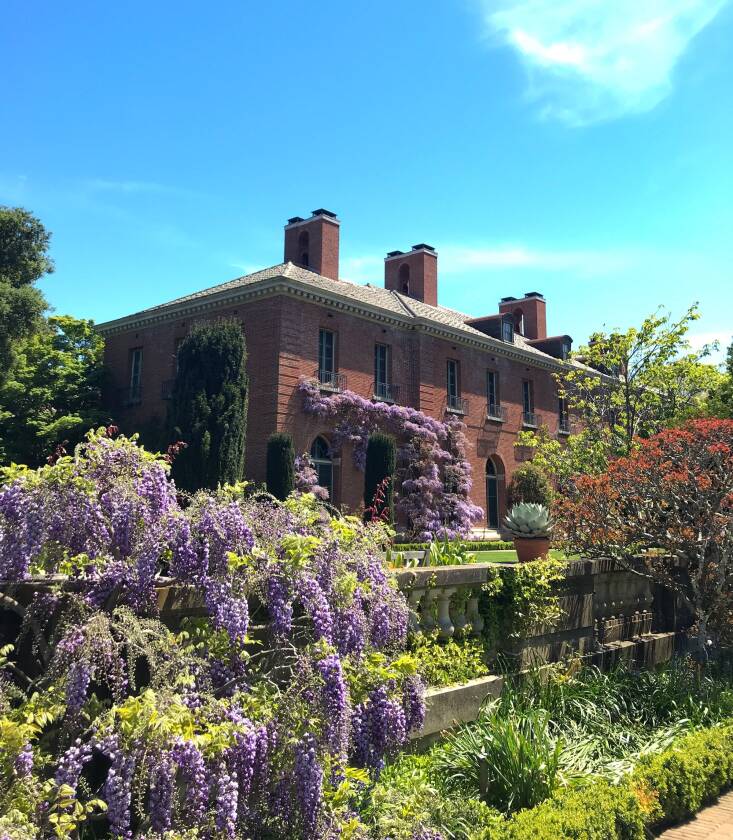I don’t know about you, but when I step inside a historic garden, I immediately feel like a character in a classic English novel—ready to frolic on the vast green lawn, stroll with a parasol through the boxwood-lined borders, and pause on a bench to take in the enchanting view. When I recently toured Filoli in Woodside, CA, this Merchant and Ivory feeling came over me. Though tempted, I didn’t frolic on the lawn, but I did take time to marvel at the pretty colors and tidy shapes and lines, all in concert with the natural oak-studded surroundings.
Filoli is a historic estate worth visiting and admiring (and if you are so inclined, frolicking through.) Please join me as we tour around the spring horticultural tableaux at Filoli.
Photography courtesy of Filoli.
A Little History

Nestled on a slope of the Santa Cruz Mountains and surrounded by more that 23,000 acres of protected land, Filoli was created to fulfill William and Agnes Bourn’s vision of a private self-sustaining country estate. William Bourn II dubbed it Filoli (pronounced ‘Fie-low-lee’) by grabbing the first letters of his personal motto: ‘FIght for a just cause; LOve your fellow man; LIve a good life.”

The house, designed by architect Willis Polk, was completed in 1920 and the formal Garden completed in 1929. The second owners, the Roths, purchased the garden in 1937 and then after William Roth died, his wife donated the house and garden to the National Trust for Historic Preservation in 1975, explaining, “Filoli is too beautiful to be private.” Mrs. Roth also said, “I have always felt that such a place should be preserved…and made a center of horticulture and cultural activities.”
Two Gardens in One

Filoli’s Garden integrates two English styles. The 18th century Georgian style, consistent with the houses’ architecture, is represented in the more naturalistic terraces and outer landscape, where the human hand on the land was intended to blend into the existing environment.

The southern garden areas were designed in the formal English Renaissance style, with a strict attention to geometry as seen in the Irish yew-lined allée, the separate purpose-driven garden “rooms,” centerpiece sculptures and water features, and the dramatic sunken garden (a defining feature of English-style gardens.)
The Seasons of Filoli

Every season gifts the visitor something special. Winter allows you to appreciate the spectacular structure or ‘bones’ of the garden. Stately evergreens stand out, bare tree architecture holds a new importance, and 10-foot-high brick walls and wrought-iron gates become more prominent. Camellias, magnolias, orchids, and citrus are blooming. Plus when you visit the house, you can learn how Filoli’s owners connected the inside of their home to the garden outside through fresh floral arrangements that were picked from the Cutting Garden. (The House even has a designated Flower Arranging Room.)

In the spring, tulips, daffodils, cherry blossoms, and, of course, wisteria take center stage. Summer is the perfect time to attend their Summer Nights program and take in the roses and dahlias. Fall gifts visitors with a kaleidoscope of autumnal colors.
According to Dani Hielscher, Filoli’s Marketing Coordinator, spring and holidays at Filoli are the most popular times to visit, but the reason people come is always the same. “People come to Filoli to find respite in nature, appreciate beauty, and to spend time with their loved ones.”
Looking Ahead

Kara Newport, Filoli’s CEO, tells me that, “Water conservation has been a long conversation in the Bay Area, and even Filoli’s original owners integrated sustainable concepts into the original garden design using a Mediterranean palette. As we look to the future of sustainable gardening at Filoli, we consider climates from around the globe including Mediterranean and arid climates along with our own California native plants.” Kara goes on to share that “this summer’s formal garden display allows us to combine a sustainable option with a modern aesthetic.”
Dani adds that Filoli is also focused on providing a greater narrative around water. She explains, “Filoli’s landscape tells a broad story of California history with water as one connective thread; from Ohlone villages nestled along creek beds to the Bourn’s industrial reservoir holding San Francisco’s water supply. The changing climate and landscape is one that any Californian can relate to, and our most valuable resource is at the heart of it.” One water-conscious hardscape change is the dining room terrace renovation, where the existing thirsty lawn will be replaced with bluestone.

Another recent project involves the vegetable garden. For the past 40 years, a cooperative vegetable garden for the staff has been closed to the public. The new plan transforms the space into a central resource for information and inspiration for those people seeking comfort, food security, and safe outdoor experiences via gardening. New raised beds are being built for greater accessibility, plus dedicated seating areas for outdoor learning and live demonstrations. Filoli will also cultivate culturally specific plants and plants used by Indigenous people and regional immigrant populations.
For more on California gardens, see:
- Poppies in Paradise: A Garden Visit in Healdsburg, California
- 7 Landscaping Ideas to Borrow From Northern California’s Wine Country
- Required Reading: Ruth Bancroft’s Bold Dry Garden









Have a Question or Comment About This Post?
Join the conversation